Tailoring treatments for high-grade gliomas
A new study aims to improve outcomes for patients with highgrade gliomas. Researchers are using mouse models to test the combination of surgery, chemotherapy and radiotherapy treatment for Glioblastoma multiforme (GBM), a Grade IV primary astrocytic tumor.
“Ultimately, we would like to develop a system where we could grow each individual patient’s brain tumor in this model and test several different therapies to see which would work best. It’s a sort of tailoring treatments based on each patient’s specific tumor biology,” said Neurosurgical Chief Resident Mike Decuypere, MD, PhD.
The research is led by the University of Tennessee Health Science Center departments of Neurosurgery and Pathology and the UTHSC Center for Cancer Research and funded by UT-West Cancer Center.
GBM has a poor overall prognosis, significant morbidity and limited therapeutic options. Death typically occurs within 15 months of diagnosis, even after maximal surgical and medical treatment.
The current treatment paradigm of surgical resection, chemotherapy and radiation has poor overall results. This is due, in part, to the lack of accurate pre-clinical animal models that mimic the true disease state and are able to undergo the gamut of treatment options.
This project will compare the relative efficacies of various treatment protocols for human glioblastoma, orthotopically xenografted in a murine model. Survival intracranial resection surgery will be used in conjunction with several post-operative chemotherapy protocols using irinotecan and bevacizumab in hopes of generating data useful to human clinical trials.
Help us provide the best care for kids.
Le Bonheur Children's Hospital depends on the generosity of friends like you to help us serve 250,000 children each year, regardless of their family’s ability to pay. Every gift helps us improve the lives of children.
Donate Now


